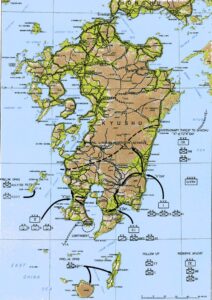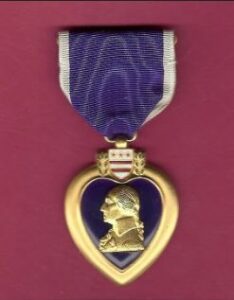 Near what is now known to be the end of World War II, a plan was devised to invade the Japanese home islands. In the end, Operation Downfall was not carried out, because Japan surrendered following the atomic bombings of Hiroshima and Nagasaki, the Soviet declaration of war, and the invasion of Manchuria. Nevertheless, in the days and months leading up to the planned attack, with its two parts…Operation Olympic and Operation Coronet, the United States Armed Forces ordered 1 million Purple Heart medals, in anticipation of a bloody battle. Operation Olympic was set to begin in November 1945, and was intended to capture the southern third of the southernmost
Near what is now known to be the end of World War II, a plan was devised to invade the Japanese home islands. In the end, Operation Downfall was not carried out, because Japan surrendered following the atomic bombings of Hiroshima and Nagasaki, the Soviet declaration of war, and the invasion of Manchuria. Nevertheless, in the days and months leading up to the planned attack, with its two parts…Operation Olympic and Operation Coronet, the United States Armed Forces ordered 1 million Purple Heart medals, in anticipation of a bloody battle. Operation Olympic was set to begin in November 1945, and was intended to capture the southern third of the southernmost  main Japanese island, Kyushu, with the recently captured island of Okinawa to be used as a staging area. The second attack was planned for early 1946. Operation Coronet was supposed to be the invasion of the Kanto Plain, near Tokyo, on the main Japanese island of Honshu. Important airbases on Kyushu that would be captured in Operation Olympic would allow land-based air support for Operation Coronet. If Downfall had taken place, it would have been the largest amphibious operation in history…even surpassing D-Day.
main Japanese island, Kyushu, with the recently captured island of Okinawa to be used as a staging area. The second attack was planned for early 1946. Operation Coronet was supposed to be the invasion of the Kanto Plain, near Tokyo, on the main Japanese island of Honshu. Important airbases on Kyushu that would be captured in Operation Olympic would allow land-based air support for Operation Coronet. If Downfall had taken place, it would have been the largest amphibious operation in history…even surpassing D-Day.
This planned set of attacks was no mystery to Japan either, because their geography made this invasion plan quite obvious. The Japanese were able to accurately predict the Allied invasion plans, and they adjusted their defensive plan, known as Operation  Ketsugo, accordingly. The Japanese planned an all-out defense of Kyushu, with little left in reserve for any subsequent defense operations. Casualty predictions varied widely, but they were expected to be extremely high. Depending on the degree to which Japanese civilians would have resisted the invasion, estimates ran up into the millions for Allied casualties. No wonder the United States expected to need 1 million Purple Heart medals. Thankfully, those millions of Allied casualties never materialized, because when the atomic bombs were dropped on Hiroshima and Nagasaki, the war ended. The United States was left with 1 million Purple Heart medals, which they are still using today. I think that while having 1 million Purple Heart medals isn’t the worst thing ever, just the fact that we still have some of those 1 million Purple Heart medals means that, in some way, we have kept some of our soldiers safe over the years. I don’t know how many are left, but it doesn’t matter, because at this point, 78 years later…there are some left.
Ketsugo, accordingly. The Japanese planned an all-out defense of Kyushu, with little left in reserve for any subsequent defense operations. Casualty predictions varied widely, but they were expected to be extremely high. Depending on the degree to which Japanese civilians would have resisted the invasion, estimates ran up into the millions for Allied casualties. No wonder the United States expected to need 1 million Purple Heart medals. Thankfully, those millions of Allied casualties never materialized, because when the atomic bombs were dropped on Hiroshima and Nagasaki, the war ended. The United States was left with 1 million Purple Heart medals, which they are still using today. I think that while having 1 million Purple Heart medals isn’t the worst thing ever, just the fact that we still have some of those 1 million Purple Heart medals means that, in some way, we have kept some of our soldiers safe over the years. I don’t know how many are left, but it doesn’t matter, because at this point, 78 years later…there are some left.


Leave a Reply